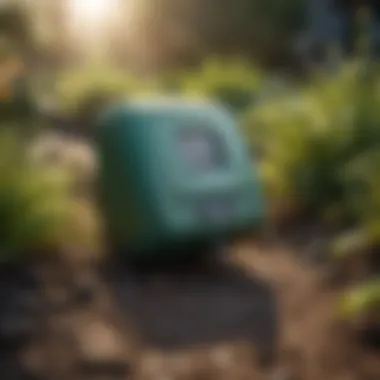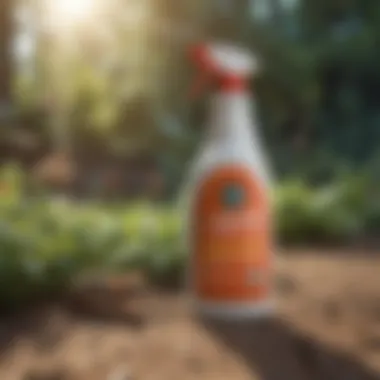Effective Strategies for Keeping Rats Away from Your Garden


Preventive Pest Control Strategies
When envisioning a flourishing garden, the last thing one desires is an invasion of pests like rats. Embarking on a journey towards maintaining a pristine garden necessitates a vigilant stance against these unwelcome visitors. To safeguard your garden ecosystem effectively, incorporating preventive pest control strategies becomes quintessential. Let us delve into various facets of pest control, starting with fortifying the perimeter of your abode.
House Exterior Protection
As the first line of defense against pest infiltration, the exterior of your house plays a pivotal role. Simple yet crucial tips for sealing cracks where pests may sneak in need immediate attention. Additionally, clearing debris in and around your garden area discourages pests from finding potential hiding spots. Ultimately, preventing pests from breaching your living space is paramount.
Tips for sealing cracks
Commence by meticulously examining the exterior of your house, focusing on entry points. It is imperative to seal any crevices or openings where rats could potentially gain access. Utilizing high-quality sealants ensures a durable barrier, thwarting their attempts at invading your sanctuary.
Clearing debris
A clutter-free environment is unattractive to rodents seeking hiding spots. Regular maintenance of your garden area by removing unnecessary debris not only enhances its aesthetic appeal but also eliminates potential shelters for pests.
Preventing pests from entering
Implementing proactive measures such as installing mesh screens on windows and doors significantly reduces the likelihood of pests infiltrating your living space. Consistent vigilance and maintenance are imperative to creating a fortress against potential rodent invasions.
Yard Maintenance
To preserve the integrity of your garden and deter pests effectively, adhering to essential yard care routines is crucial. Whether it entails mowing the lawn regularly or pruning shrubs, every effort contributes to fostering a pest-free environment.
Essential yard care routines
Scheduled maintenance activities such as weeding, watering, and lawn mowing enhance the visual appeal of your garden while simultaneously impeding pest harborage. Maintaining a well-kept yard diminishes potential attractants for rodents, thus safeguarding your sanctum from infestations.
Methods for keeping yard pest-free
Incorporating pest-resistant plants, proper waste disposal, and adequate lighting in your yard serves as formidable deterrents against unwanted critters. Furthermore, cultivating a harmonious ecosystem within your garden nurtures a thriving habitat while deterring pest nuisances.


Indoor Cleanliness
A hygienic indoor environment serves as a bastion against pest invasions, particularly for notorious culprits like rats. Expert cleaning tips and techniques can fortify your living space, rendering it inhospitable to unwelcome intruders.
To be continued
Understanding the Threat of Rats in Your Garden
Rats pose a significant threat to the well-being of your garden ecosystem, necessitating a deep dive into understanding their behavior and impact. Their presence can result in widespread devastation, ranging from destruction of plants to potential health hazards. These rodents are not merely nuisances; they are formidable adversaries to your garden's vitality. By comprehensively analyzing the threat of rats, garden owners can proactively safeguard their green spaces and maintain a harmonious environment free from these troublesome intruders.
Recognizing the Impact of Rat Infestation
Destructive Behavior of Rats in Gardens
We must shed light on the perilous behavior exhibited by rats in gardens. Their relentless gnawing and foraging habits can swiftly decimate crops, uproot plants, and disrupt the delicate balance of your garden. The insidious nature of their destruction knows no bounds, making it imperative to address this aspect with utmost urgency. Understanding the magnitude of their destructive tendencies equips gardeners with the knowledge needed to combat this persistent threat effectively.
Health Risks Associated with Rat Infestation
In addition to their penchant for destruction, rats carry a host of health risks that can jeopardize the well-being of individuals and pets. From spreading diseases through their droppings to contaminating food sources, rat infestations pose a serious risk to human health. Heightened awareness of these dangers underscores the critical importance of eradicating rat infestations promptly. By grasping the health hazards linked to rats, garden owners can prioritize proactive measures to ensure a safe and hygienic outdoor space.
Identifying Common Signs of Rat Presence
Scattered Droppings
The presence of scattered droppings serves as a telltale sign of rat activity in your garden. These unsightly remnants not only indicate their unwelcome presence but also emphasize the urgency of addressing the infestation. By closely monitoring areas where droppings are prevalent, gardeners can pinpoint hotspots of rat activity and implement targeted strategies to deter them effectively.
Gnaw Marks on Plants and Structures
Gnaw marks left behind by rats on plants and structures signify the extent of their intrusion into your garden sanctuary. These distinctive markings, characterized by their irregular patterns and depth, offer concrete evidence of rat infestation. Recognizing the distinctiveness of these gnaw marks empowers garden owners to promptly intervene and fortify their defenses against these persistent pests.
Implementing Natural Deterrents
When embarking on the journey to safeguard your precious garden from the persistent threat of rats, implementing natural deterrents plays a pivotal role in warding off these pesky intruders. Pesticides


Installing Physical Barriers
When it comes to protecting your garden from rat infestation, installing physical barriers plays a crucial role. These barriers serve as the first line of defense against unwanted rodents, preventing them from accessing your plants and stored items. By implementing physical barriers, you create obstacles that deter rats, minimizing the risk of damage and contamination. One must consider various factors such as material durability, barrier height, and installation method to ensure maximum effectiveness.
Building Fences and Enclosures
Selecting Solid Materials
Selecting the right materials for building fences and enclosures is paramount to their efficacy. Solid materials like metal, concrete, or sturdy wood offer durability and resilience against rat intrusions. Metal fences are hard for rats to gnaw through, while concrete barriers provide a permanent solution. Wood, when treated correctly, can also be a robust option. Opting for high-quality materials ensures longevity and sustainable protection.
Ensuring Proper Installation
Beyond material selection, ensuring proper installation is key to the effectiveness of physical barriers. Properly installed fences and enclosures leave no gaps or weak points that rats can exploit. Consider factors like depth of installation, secure anchoring, and seamless connections between sections. A well-installed barrier not only prevents rat entry but also enhances the overall aesthetics of your garden.
Securing Compost Bins and Storage Areas
Tightly Sealed Lids
Tightly sealed lids on compost bins and storage areas are essential in denying rats easy access to food sources. These lids prevent odors from escaping, which might attract rodents. Choose lids that lock securely in place and are made of durable materials resistant to rat tampering. Regularly check the seals to ensure they remain intact and functional.
Elevated Placement
Elevating compost bins and storage areas adds an extra layer of protection against rats. Placing these containers at a height that rats cannot easily reach deters them from scavenging through the contents. Ensure the elevated platforms are stable and not prone to tipping over. Elevating these areas not only prevents rat interference but also aids in organizing your garden space effectively.
Utilizing Humane Traps
Utilizing humane traps is a pivotal aspect in the comprehensive guide to effectively keeping rats out of your garden. When it comes to pest management, humane traps offer a humane approach that ensures the rodents are captured without harm, allowing for their safe release away from your garden environment. This method not only safeguards your plants but also maintains ecological balance within your surroundings. By utilizing humane traps, you are effectively addressing the rat infestation without resorting to harmful chemicals or inhumane practices, aligning with the principles of ethical pest control practices.
Choosing and Setting Up Humane Traps
Live Capture Traps


Live capture traps are an integral part of humane pest control strategies. These traps are designed to capture rats alive, minimizing any potential harm to the animals during the trapping process. The key characteristic of live capture traps lies in their ability to capture rats unharmed, promoting a humane approach to pest control. Their unique feature lies in the mechanism that allows for the safe containment of rats without causing them undue distress. While live capture traps are a popular choice due to their humane nature, they do require regular checks to ensure caught rats are promptly released to avoid stress and dehydration.
Proper Placement for Maximum Effectiveness
Strategically placing humane traps is crucial for their optimal performance in rat capture. Proper placement ensures that traps are located in areas frequented by rats, increasing the likelihood of successful capture. The key characteristic of proper trap placement is to identify high-traffic areas where rats traverse frequently, such as along walls or near food sources. This placement enhances the effectiveness of the traps, improving the probability of successful captures. A unique feature of proper trap placement is its ability to outsmart the rats by placing traps in hidden corners or narrow pathways where rats feel secure, increasing their chances of being captured. However, it is essential to place traps away from children or pets to prevent accidental encounters with the traps.
Releasing Captured Rats Responsibly
Selecting a Suitable Release Site
Selecting a suitable release site is a critical step in the humane trapping process. The key characteristic of a suitable release site is its distance from your home, ensuring that released rats do not find their way back into your garden. This choice is beneficial for maintaining a rat-free environment and preventing reinfestation. A unique feature of selecting a suitable release site is to opt for areas with natural habitats, such as wooded areas or fields, providing rats with a familiar environment for their relocation. However, avoid releasing rats near residential areas to prevent conflicts with human populations and potential re-entry into urban settings.
Avoiding Harm During Release
Avoiding harm during the release of captured rats is essential for upholding humane pest control practices. The key characteristic of this process is to handle traps with care to prevent accidental injuries to the captured rats during their release. This choice is beneficial for ensuring the ethical treatment of pests and upholding the principles of compassion in pest management. A unique feature of avoiding harm during release is to use protective gear, such as gloves, to safeguard yourself from potential bites or scratches while handling traps. However, take caution to avoid direct contact with the rats and release them gently into their new environment, allowing them to adapt to their surroundings without distress.
Seeking Professional Assistance
In the realm of protecting your garden from the unwanted invasion of rats, the significance of seeking professional assistance cannot be overstated. When faced with a rat infestation situation, it is vital to understand that pest control experts bring specialized knowledge and tools to effectively address this problem. By engaging with professionals in the field, you not only ensure a systematic approach toward rat elimination but also gain access to expert guidance tailored to the unique needs of your garden. Entrusting this task to professionals can greatly enhance the efficiency and success of rat deterrence efforts.
Consulting Pest Control Services
Evaluating Infestation Severity
In the context of combating rat infestations, evaluating the severity of the infestation emerges as a critical initial step. This process involves a comprehensive assessment of the extent and impact of rat presence in your garden, enabling pest control specialists to devise appropriate strategies. Understanding the level of infestation severity allows for the implementation of targeted and effective eradication methods. By accurately evaluating the magnitude of the rat issue, tailored solutions can be formulated to address the specific challenges posed by these rodents.
Customized Treatment Plans
Customized treatment plans play a pivotal role in the overarching goal of rat deterrence. These plans are specifically tailored to address the unique characteristics of the rat infestation in your garden. By customizing treatment approaches based on factors such as the type of rat species present, the size of the infestation, and the layout of the garden, pest control services can optimize the effectiveness of their interventions. Such personalized strategies not only enhance the efficiency of rat eradication but also contribute to the long-term sustainability of a rat-free environment in your garden.
Implementing Long-Term Prevention Strategies
Regular Inspections
The practice of conducting regular inspections holds immense value in the context of sustaining a rat-resistant garden. Regular inspections allow for the early detection of any potential rat incursions, enabling prompt intervention before the situation escalates. Through thorough and systematic inspections, house owners can proactively identify vulnerable areas in their garden that may attract rats and take preventive measures accordingly. By integrating regular inspections into their maintenance routine, individuals can uphold a vigilant stance against rat invasions and fortify the defenses of their outdoor spaces.
Sealing Entry Points
An indispensable aspect of long-term rat deterrence involves the meticulous task of sealing entry points to prevent rodent access to the garden. Identifying and sealing off potential entryways that rats may exploit to infiltrate the premises is paramount in creating a secure barrier against these pests. By fortifying your garden's perimeter with effective sealing measures, such as filling gaps in fences, sealing cracks in walls, and securing openings in structures, you can significantly reduce the risk of rat intrusion. Sealing entry points acts as a formidable line of defense in safeguarding your garden and maintaining a rat-free environment for the long term.



